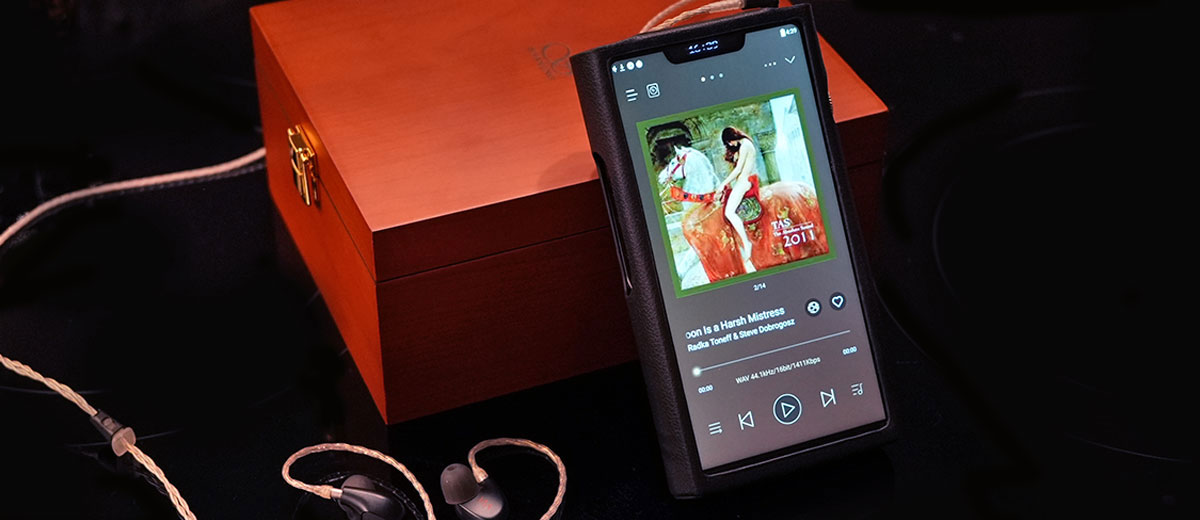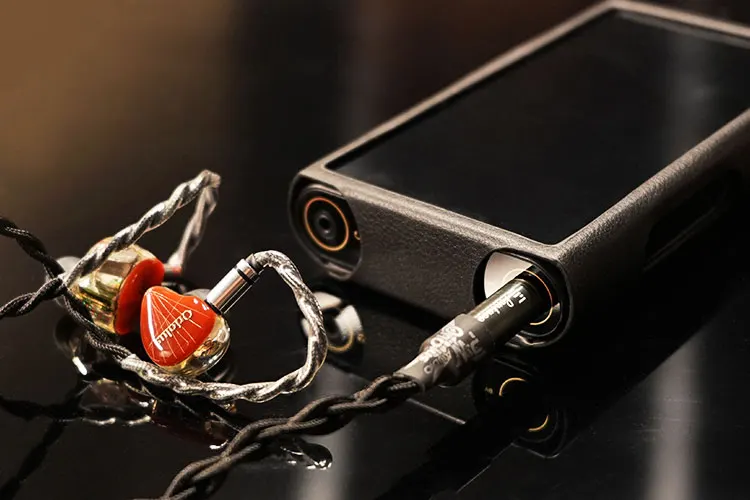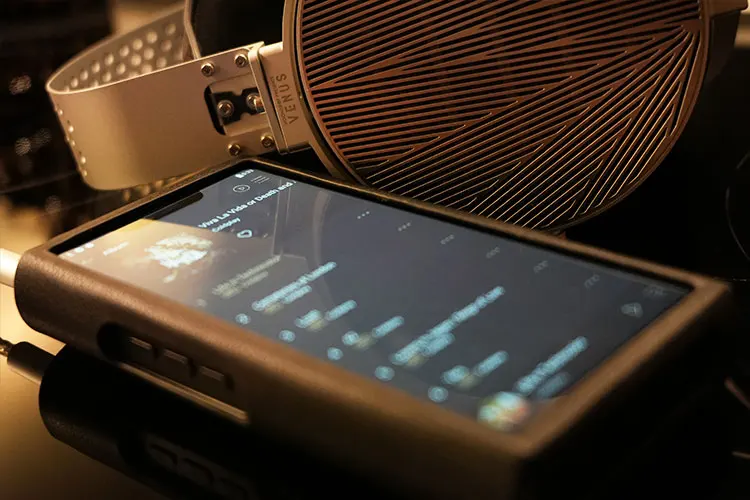Software Impressions
Android 10
The 64-bit Android 10 OS supporting OS-wide SRC bypass is customized but very responsive when indexing songs and scrolling through a large library. When multitasking, the Octa-core Qualcomm controller and the 8GB RAM are more than sufficient to keep it fast without any issues like force quitting.
However, with competing DAPs using Android 11 and Android 12 such as the HiBy RS8, from a user perspective, I do hope Shanling will move on to a newer OS sooner to align with the experiences on phones.
However, it’s important to note that newer Android OS versions may require higher hardware specifications, such as more powerful controllers and higher RAM, which may not be the highest priority for DAP designs that needs to save more power for decoding and amplification.
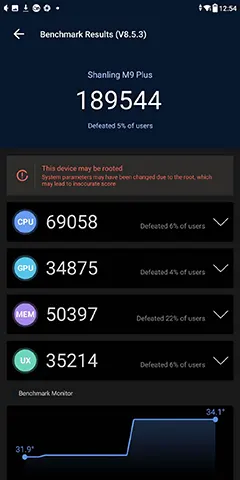

Performance Numbers
Before any applications are installed on the M9 Plus, its AnTuTu benchmark score is 189544, which is slightly higher than the M9‘s score of 185728.
The M9 Plus shows an improvement of over 12% in Memory performance. In terms of CPU score, the M9 Plus slightly outperforms the DX320 MAX Ti with a score of 69058 compared to DX320MAX’s 67143.
The M9 Plus also exhibits significantly better RAM performance with a score of 50397 compared to DX320 MAX Ti’s 38546. The M9 Plus benefits greatly from its fast memory, which results in a very smooth navigation experience and faster loading speed.
UI Flow
When dragging down the top menu, users can access the PO/LO switch, gain level, and Turbo mode for headphones. For more advanced audio settings, users can go into the audio settings menu to change digital filters, prioritize the codec used for Bluetooth decoding, and choose the decoding quality.
Additionally, users can toggle settings like dark mode or enter Prime mode to further customize their audio experience.
It is recommended to update to the latest firmware when you get your hands on a new unit as Shanling will always update their firmware from time to time to eliminate bugs and enhance functions.
Its OTA feature by pressing on the lightbulb icon and on the current firmware the M9 Plus supports the Google Play store for international users.


Shanling Music App
If you do not have other preferences, the inbuilt Shanling Music App offers smooth and comprehensive playback functions customized for the M9 Plus with features like cover art view, VU-meter visualizations, wireless music transfer from PC, etc.
In addition, the Shanling Music App also supports Synclink control for users who want to control the player via mobile phones. The M9 Plus also supports connections to NAS and reads the music files inside.
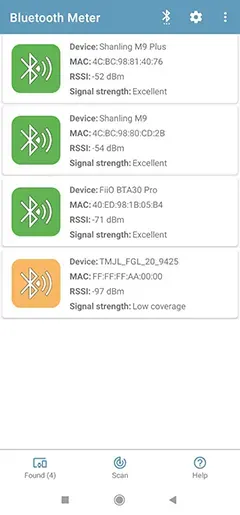

Wireless Connectivity
Bluetooth Strength
The M9 Plus supports LDAC down to SBC Codecs as well as aptX HD as a transmitter and pleasingly up to LDAC as a receiver. DAPs such as the DX320 MAX Ti only offer SBC as a receiver.
Using the hotspot strength meter app, I compared the signal strength between the M9 Plus and M9 which shows excellent connectivity last time when I tested it 2 meters away from the source which is my phone.
As expected, using the RSSI, (Received Signal Strength Indicator), both M9 Plus and M9 are rated excellent in connection strength. In practice, streaming across the living room to the FiiO BTA30 Pro receiver is very stable and connection to TWS is very smooth without hearing the signal drop.
WiFi Strength
Using a WiFi meter similar to the Bluetooth tester above, the M9 Plus displays similar signal strength to the M9 which also uses the same chipsets.
Tested from the same physical spot both devices show excellent strength. Moving behind doors and a thick wall and the connection still manages to hold nicely without delays or sudden drops.
Streaming
Similar to the M9, the new M9 Plus can unfold MQA fully with 16x unfolding power. Tidal users can enjoy the MQA unfold power to step up the sampling rate and smoothen the output, and local MQA files can also be upsampled.
The Qualcomm WCN3980 wireless module used on the player supports a 2.4/5G Wi-fi Signal and MIMO technology that enables multiple connections with other devices at the same time.
With fast internet, the streaming experience is seamless even when stress testing with high-resolution videos on YouTube.
Sound Impressions
Summary
The Shanling M9 Plus features a significantly improved I/V stage and DAC design, resulting in a significant increase in driving power compared to its predecessor.
There is adequate power to drive almost all IEMs and some of the more demanding headphones. The device is capable of producing airy, highly dynamic sound with abundant microdetails and separation power.
The new design has taken a more “HiFi Tuning”, reference-styled approach, moving away from their previous vocal-focused tuning that at times thickens the nasal tones and overemphasized lower mids and transients, compromising the overall openness.
The output being more tonally balanced also gives it higher versatility in pairing, additionally, the 3.5mm output is not compromised and sounds equally dynamic and highly resolving.
The quad-DAC implementation is indeed a key factor in the excellent control and overall sound quality of the Shanling M9 Plus.
Despite not being the most powerful device on paper or having the strongest character, the M9 Plus delivers exceptional musicality and definition that makes it an all-rounder among digital audio players. I find it quite a bit stronger in texture and musicality compared to the H7 portable DAC and amplifier during a brief listen.
Timbre
The M9 Plus sounds revealing and vivid. More so than the M9, and has a stronger sense of precision.
In the tuning, there is also a small hint of the same signature meatiness from the M9 Plus which gives the lower register more mass, yet it sounds tonally more precise as the vocal is weight closer to neutral and is naturally textured but not overly elevated for clarity.
There is audibly much stronger control and precision than other Shanling players I have listened to so far. While the vocal range is not as elevated the extension towards the subsonic region seems to be enhanced, as I can hear more clearly how the bass disperse playing back big Japan drums albums as well as some house mixes.
It is almost like listening to an A/C-powered desktop amplifier in terms of the density of the bass notes and bass responsiveness, which I have experienced with the FiiO M17. Despite that, the M9 Plus is tuned to sound more dynamic and relaxed on the low end.
The tuning focuses on precision than sheer power, as suggested by the enhanced stereo image of instruments and rich harmonics, as well as the quality reverberation of string instruments that don’t sound dampened even on high gain and volume.
Balance
In addition to delivering excellent dynamics, the Shanling M9 Plus also excels at presenting a well-balanced bass and sub-bass, which provides a stronger sense of control and precision and contributes to a more expansive sound.
When listening to classical music, it feels more realistic as the reverberation and depth are depicted in a much more detailed manner.
You may have guessed that the treble extension is also improved to sound more effortless, with sharp notes dampened just right and good air retained. Cymbals and high-pitched notes are clearly and naturally presented with good brilliance, and I can clearly hear where it is radiating from and how they disperse into the air.
Benefiting from the balanced tuning and vast dynamic range, overall articulation is exceptionally smooth, vivid, and energetic. The mids are not expressive as the M8 though it is cleanly and loyally presented with excellent precision and texture. It is also well separated from the backing instruments and has decent penetration power.
For some listeners, the tuning may be slightly on the clean side so a bit of EQ may be of great help to make voices more crispy or even fuller.
Staging & Dynamics
Striking a great balance between power and control, Shanling pictures a realistic and spacious soundstage.
It’s akin to experiencing a live performance in a large lecture hall with good acoustics, where the musicians and their instruments are positioned at a distance from the audience, yet the sound energy is robust enough to easily pinpoint their source clearly.
Testing with various in-ear monitors, the M9 Plus impressively produces dynamic and impactful sound, particularly in the lower frequency range, resulting in a more spacious and immersive soundstage.
The bass transients are also exceptional, delivering distinct separation for each synthesized bass instrument even at higher volumes, and maintaining precise positioning for larger ensembles.
It’s worth noting that the M9 Plus stands out as a more powerful upgrade from the M9 in this aspect, giving tighter, more textured transients to pump up the overall resolution.
Synergy
Efficiency
The M9 Plus is very quiet with sensitive IEMs, and it can sound very dynamic and detailed on low gain. When I am listening outdoors with custom IEMs or IEMS with a strong seal like the Etymotic EVO, I can barely hear any noise in the background.
It is always the noise floor in the mix that hisses as noise control has been much enhanced on DAPs nowadays, and it doesn’t feel filtered or dampened on the M9 Plus while the bass kicks deep.
Power
We have mentioned a few times the M9 Plus has ample power for most IEMs and could power quite some headphones satisfactorily. When switched to headphone mode, it unleashes its full potential, rivaling the power output of some desktop amplifiers.
On lower gain, the M9 Plus is also versatile in pairing with sensitive IEMs to sound dynamic and resolving at the same time. With decent control, the M9 Plus is able to deliver good attack speed, texture, and resolution with most pairings I have auditioned.
Considering the size and weight the M9 Plus is very powerful and practical to put in a pocket or a satchel, without the need for an external amplifier even when you plug in small cans.
Headphone Pairings
The M9 Plus can effectively drive headphones like the Sennheiser HD650, and even the Fostex TH900 sound quite dynamic in the bass without sounding hollow.
The Moondrop Venus planar headphones which require more current output to perform optimally also sound quite dynamic and resolving on the M9 Plus, but the synergy is less comparable to headphones with dynamic drivers.
IEM Pairings
I tried pairing the M9 Plus with the Oriolus Traillii hybrid IEM next, and it is a fantastic match that sounds very lush in the vocal frequencies and has the treble zone beautifully rendered.
The multiple electrostatic drivers seem to come hand in hand in delivering very effortlessly the treble, and you can hear tons of airy details listening to soft, light voices, especially when listening to unaccompanied singing.
This is a great pairing for any relaxing music and vocal-intensive tracks, with immersive, energetic bass energy and strong definition across the mids. With the neutral-warm tuning on the M9 Plus, and its detail retrieval power it is enjoyable with all genres of music.
Testing with the 66Ω rated Westone MACH 80, the M9 Plus is a great match too which delivers strong dynamics and resolution.
There is good speed and texture in the bass which punches airily and articulates very swiftly to the mids. All instruments are precisely imaged with just the right amount of crispiness to clearly reveal themselves but without any harshness.
The Shure SE846 I tested is an exception which shows the limitation of the M9 Plus. The SE846 is 9Ω in impedance and 114dB/mW in sensitivity, which means it is very sensitive to power in either way.
The M9 Plus seems to be giving it a bit too much power even on low gain which hampers the dynamic range, though you can rely on equalizing to tweak it more euphonic. This is definitely not the most power-efficient pairing and not the case for most other IEMs and I would not recommend pairing these very sensitive gears with the M9 Plus.




